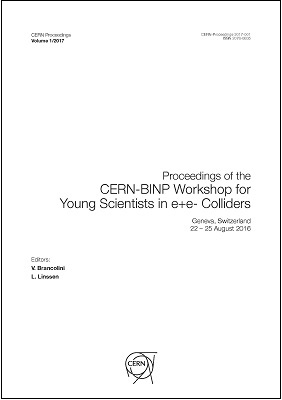Towards an Optimized Monochromatization for direct Higgs Production in Future Circular e+ e- Colliders
DOI:
https://doi.org/10.23727/CERN-Proceedings-2017-001.1Keywords:
Monochromatization, beamstrahlung, collider, high energy, high luminosity, storage ring.Abstract
Direct s-channel Higgs production in e+e- collisions is of interest if the centre-of-mass energy spread can be reduced to be comparable to the width of the standard model Higgs boson. A monochromatization principle, previously proposed for several earlier lower-energy colliders, could be employed in order to achieve the desired reduction, by introducing a nonzero horizontal dispersion of opposite sign for the two colliding beams at the interaction point. In high-energy high-luminosity circular colliders, beamstrahlung may increase the energy spread and bunch length. The horizontal emittance blow up due to beamstrahlung, a new effect which was not present in past monochromatization proposals, may degrade the performance, especially the luminosity. We study, for the FCC-ee at 62.5~GeV beam energy, how we can optimize the IP optics parameters, along with the number of particles per bunch so as to obtain maximum luminosity at a desired target value of the collision energy spread.
Downloads
Published
Issue
Section
License
Authors who publish with this journal agree to the following terms:- Authors retain copyright and grant the journal right of first publication with the work simultaneously licensed under a Creative Commons Attribution License CC-BY-4.0 (link to external page) that allows others to share the work with an acknowledgement of the work's authorship and initial publication in this journal.
- Authors are able to enter into separate, additional contractual arrangements for the non-exclusive distribution of the journal's published version of the work (e.g., post it to an institutional repository or publish it in a book), with an acknowledgement of its initial publication in this journal.
- Authors are permitted and encouraged to post their work online (e.g., in institutional repositories or on their website) prior to and during the submission process, as it can lead to productive exchanges, as well as earlier and greater citation of published work (See The Effect of Open Access).

